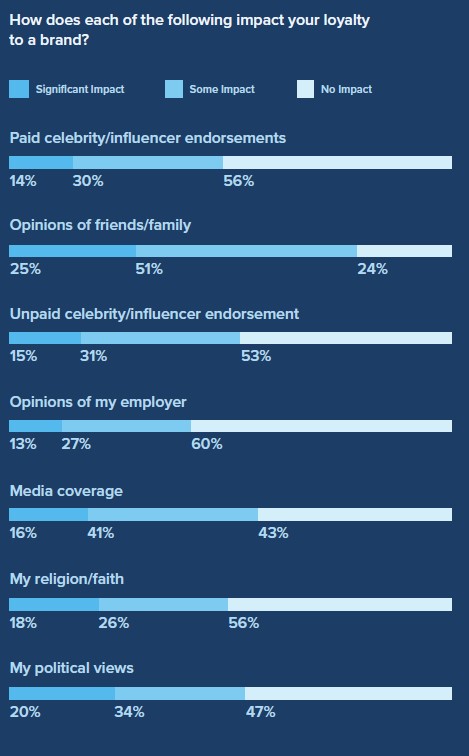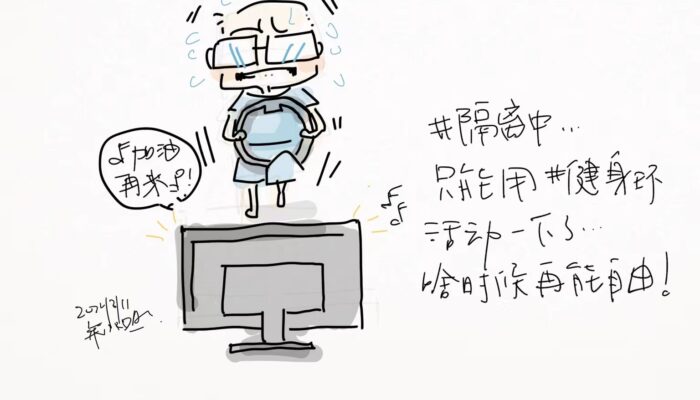
3-14 #Exercise : Samsung has established a new semiconductor package process organization; Apple has reportedly made an estimated GBP5B by no longer providing chargers and earphones with its new iPhones; Foxconn has been forced to suspend production after China partially locked down the cities of Shenzhen; etc.

According to Brand Finance, AMD is identified as world’s fastest-growing semiconductor brand, brand value up 122% YoY. In addition, AMD Chair and CEO Dr. Lisa Su is highest-ranked female chief executive in Brand Guardianship Index 2022 of world’s top 250 CEOs, claiming 10th place overall. Intel tops Brand Finance Semiconductors 20 2022 ranking as industry’s most valuable brand globally, with brand value of over USD25B. US semiconductor brands dominate ranking claiming 7 out of top 10 spots. Nvidia is strongest semiconductor brand with AAA- rating, overtaking competitors. (Brand Finance report)
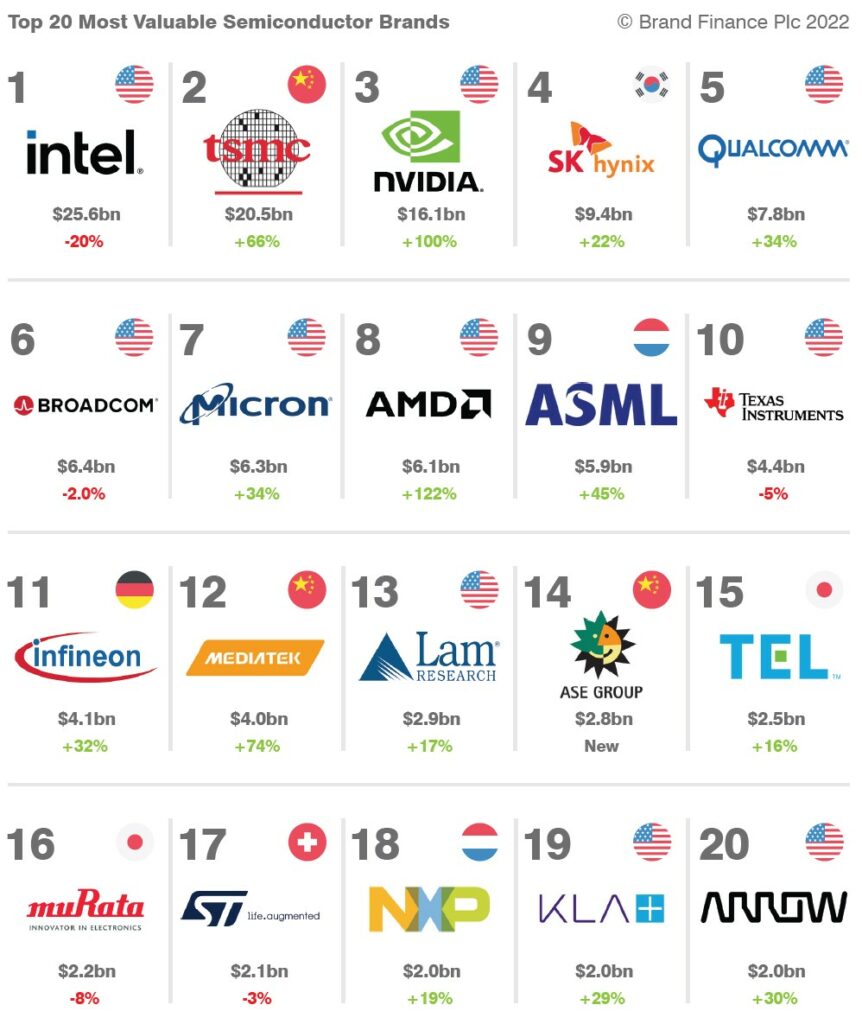
The wait times for semiconductor deliveries rose again in Feb 2022, a sign that shortages are continuing to bedevil chip buyers in a wide range of industries. Lead times – the lag between when a chip is ordered and delivered – increased by 3 days to 26.2 weeks in Feb 2022, according to research by Susquehanna Financial Group. In Jan 2022, the group reported that delays were getting shorter, the first sign of improvement since 2019. Delivery times for microcontrollers reached a high of 35.7 weeks in Feb 2022. Lead times also increased by a week and a half for power-management components. Both are essential parts of many electronics, including car components. (CN Beta, Bloomberg, Bloomberg Quint)
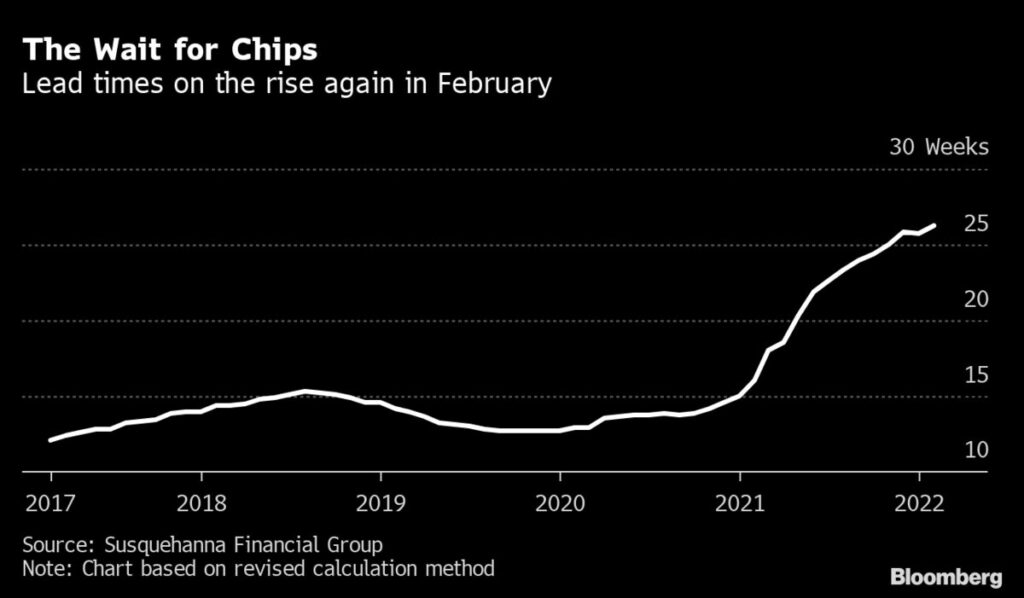
Samsung Electronics has established a new semiconductor package process organization. They have established a “Test & Package (TP) Center” within the administration of the Global Manufacturing & Infrastructure Department of the DS sector. The Global Manufacturing & Infrastructure Department manages all the processes for semiconductor manufacturing processes such as equipment, gas, chemicals, electronics, and also safe environment. The transfer of the TP center is a stepping stone for expanding infrastructure investment like building package facilities.(Laoyaoba, TechWeb, Sina, ET News)
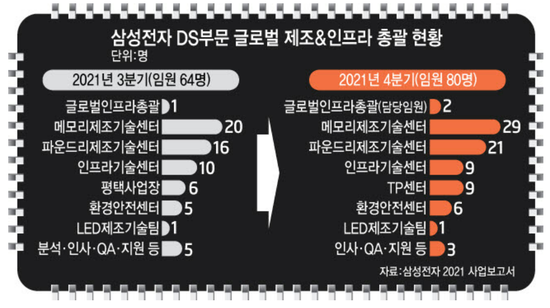
TF Securities analyst Ming-Chi Kuo has indicated that in 2022, Apple’s iPhone 14 series will adopt an unprecedented “dual-SoC strategy”. The two iPhone 14 standard models will maintain the A15 chip of the current iPhone 13, while the iPhone 14 Pro will be upgraded to the A16 chip. For this reason, Apple has stockpiled chips for the iPhone 14 series and is preparing to produce 50M A16 chips and 50M A15 chips, with the total amount 100M chipsets. He has also said that the stocking of 4nm A16 chips in 2022 is only 1/3 of that of A15 processors in 2021, indicating that only one iPhone 14 model will use A16 processors. Apple’s internal code name for the A16 processor is Crete, and the code name for the A15 processor is Ellis. Due to the adoption of a completely different product strategy, the iPhone in 2022 will also be named differently. The Pro version will be named iPhone 14 Pro and iPhone 14 Pro Max, and the non-Pro version will be named iPhone 14 and iPhone 14 Max. (CN Beta, My Drivers, TechNews, UDN, Mac Rumors)
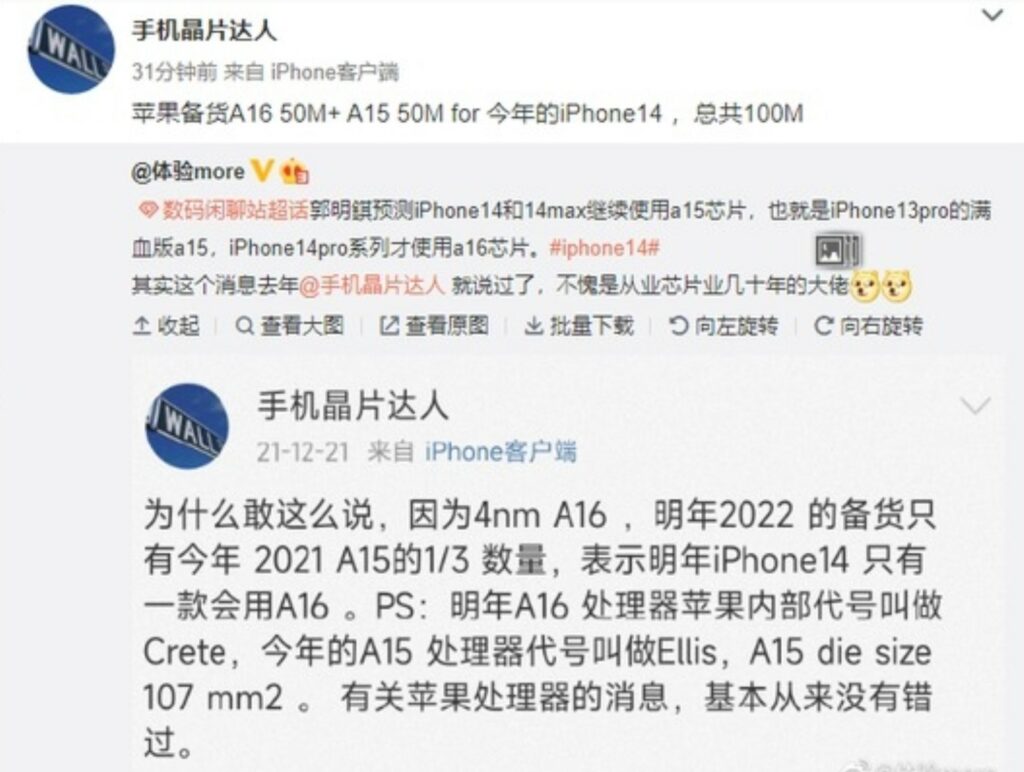
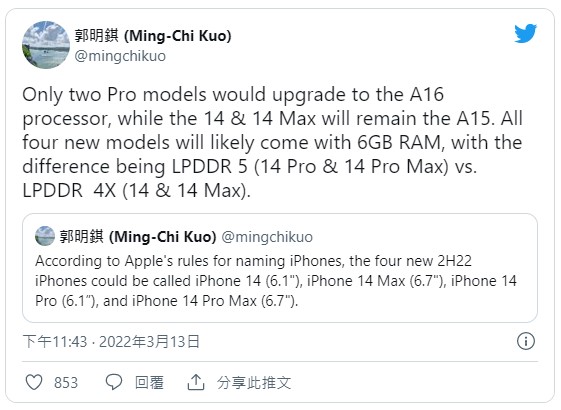

On small-size display driver IC (SDDI), customers are trying to cut prices every month. Morgan Stanley expect touch and display driver IC (TDDI) pricing to fall 5-10% QoQ in 1Q22. Their preliminary expectation is a further 5-10% cut in 2Q22, on greater pricing competition from Chinese vendors and weaker smartphone demand. OLED DDI pricing should remain stable in 1H22, but inventory days are 1-2 weeks above the norm at some Chinese OEMs. Sino Wealth said it will sample OLED DDI with key Chinese OEMs in 2Q22, and that it is likely to ramp up from 2H22. Large size display driver IC (LDDI) will likely remain stable, given the limited potential expansion in 8” foundry supply. But Morgan Stanley expects stiffer competition from Chinese suppliers in 1Q22. In addition, PC demand is normalizing, with potential weaker IT panel prices in 2Q22. (Morgan Stanley report)
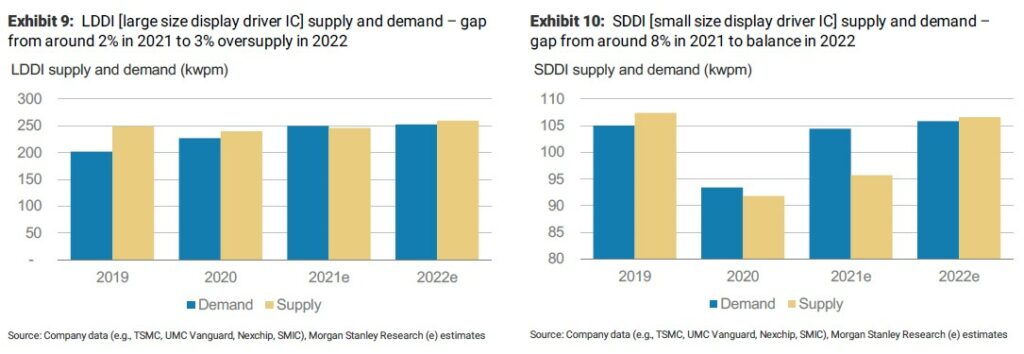
CINNO Research’s global panel factory capacity statistics show that in 2021, the overall installed capacity area of domestic AMOLED panel factories (≤G6) will only increase by 26.9%, while the production area will increase significantly by 57.0%. According to CINNO Research’s monthly panel factory commissioning survey data, the annual average utilization rate of domestic AMOLED panel factories (≤G6) in 2021 is 53.7%, an increase of 10 percentage points compared to 2020. Among them, TCL CSOT has the highest level of improvement in utilization rate, which has increased by 41 percentage points from the annual utilization rate of 32.7% in 2020 to the overall annual utilization rate of 74% in 2021. BOE is still the largest domestic AMOLED panel factory (≤G6) with the largest production area, with a market share of 37.4% in 2021, a decrease of 7.6 percentage points compared to 2020. (IT Home, Sina)
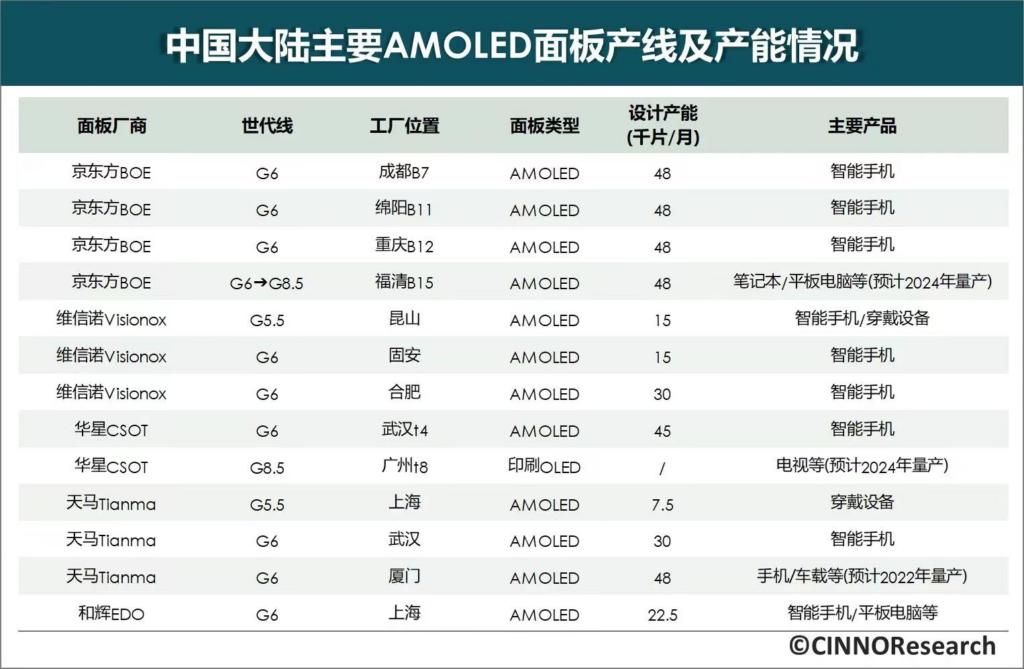
AR glasses require compact and power-efficient displays with very high contrast and brightness. Credit Suisse has a leap in AR display technology achieving these objectives, yet there is still room to improve on the yield rate and costs. Organic light emitting diodes on silicon (OLEDoS), digital light processing (DLP), and liquid crystal on silicon (LCOS) are the 3 main pathways. Initially, LCOS was the major technology for AR, for the high brightness, but it was not energy- or cost-efficient. OLED has limitations with brightness; however, breakthroughs in OLED material such as silicon substrate bridged the gap. Therefore OLEDoS (OLED on silicon) is now becoming the most popular technology due to its merits of higher contrast, power efficiency, thickness, wider temperature range, and faster response time. Although there are still many hurdles to achieving mass production, Credit Suisse believes micro-LED would be the ultimate solution for AR glasses due to its super-high brightness and contrast, excellent temperature endurance, fast response time, and low energy consumption. (Credit Suisse report)


Samsung Electronics will expand its foundry capacity in legacy nodes starting in 2022. The move is aimed at securing new customers and boosting profitability by increasing the production capacity of mature processes for such items as CMOS image sensors (CISs), which are in growing demand due to a prolonged shortage. At the same time, Samsung Electronics is planning to start volume production of advanced chips on its sub-3nm fabrication process in 1H22. Samsung Electronics plans to secure up to 300 foundry customers by 2026 and triple production from the 2017 level. (Laoyaoba, Business Korea)

According to DRAMeXchange, the Feb 2022 NAND contract price (256Gb TLC wafer) rose 8% MoM due to a rush of inventory stocking orders following the announcement of a wafer contamination issue resulting in a 13.0EB loss – equivalent to 7% of 1Q22 and 2% of 2022 total NAND shipments, based on HSBC’s estimates. The lost volume is large enough to tip the NAND market into shortage and cause major NAND customers to aggressively increase inventory over normal levels. They think the upward NAND price trend will persist until the year end since it is difficulty to add capacity quickly due to the long lead times for CVD equipment – currently 40-50 weeks compared to the normal level of 12-24 weeks. Considering the recent hike in NAND wafer contract prices, they lift their price assumptions, to +5% QoQ in 1Q22 and +6% QoQ in 2Q22 (from previously -1% QoQ in 1Q22 and +4% QoQ in 2Q22). (HSBC report)
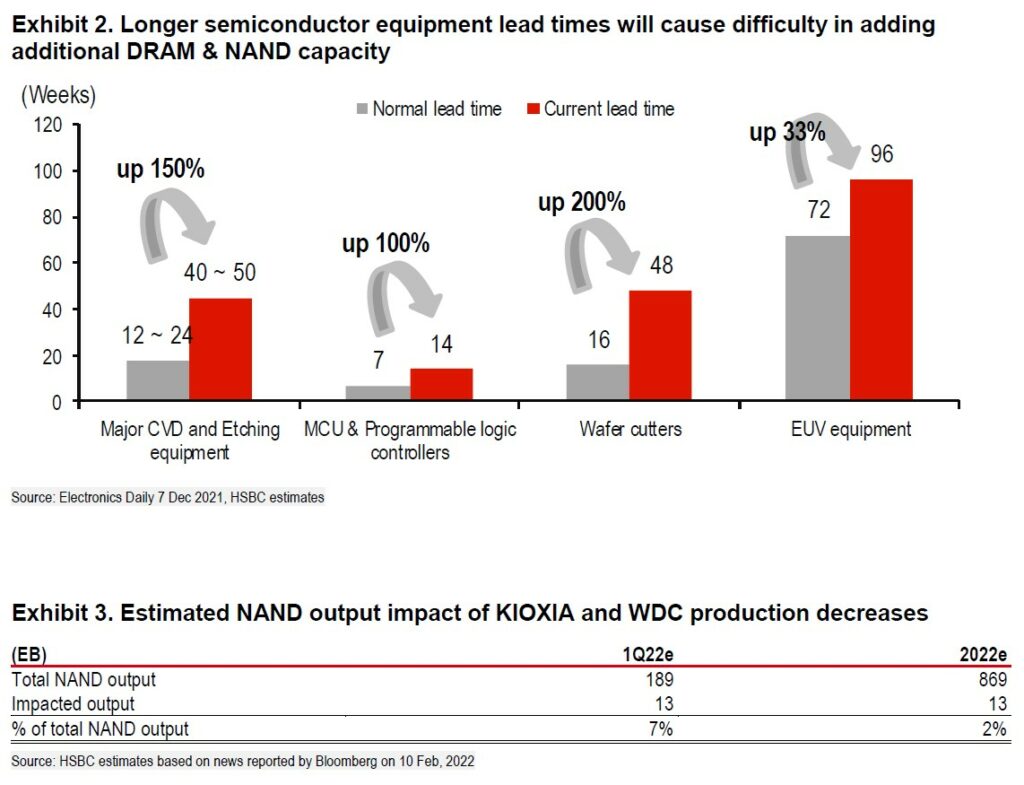
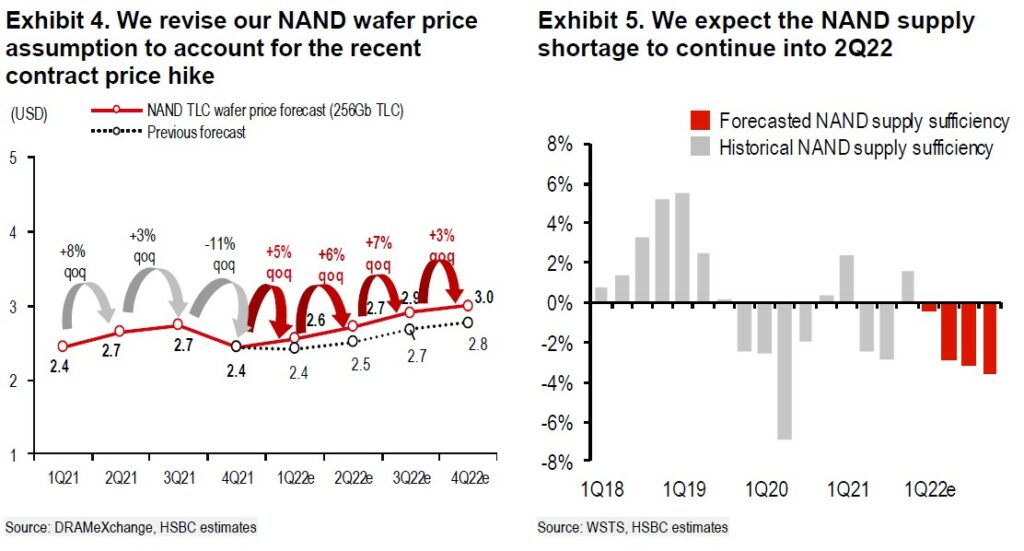
HSBC believes the 16% PC DRAM spot price premium – due to supply shortages and an increase in channel inventory – should support a slight price increase in 2Q22. In addition, even with the component shortage issue, the server DRAM price should start to show an upward trend given 1) incrementally rising CSP investment for the on-going cloud transition driving robust server demand; 2) conservative DRAM capex and capacity expansion bottlenecks due to longer equipment lead times; 3) the DDR5 impact with a 2% effective capacity reduction; and 4) the metaverse creating new infrastructure demand. (HSBC report)
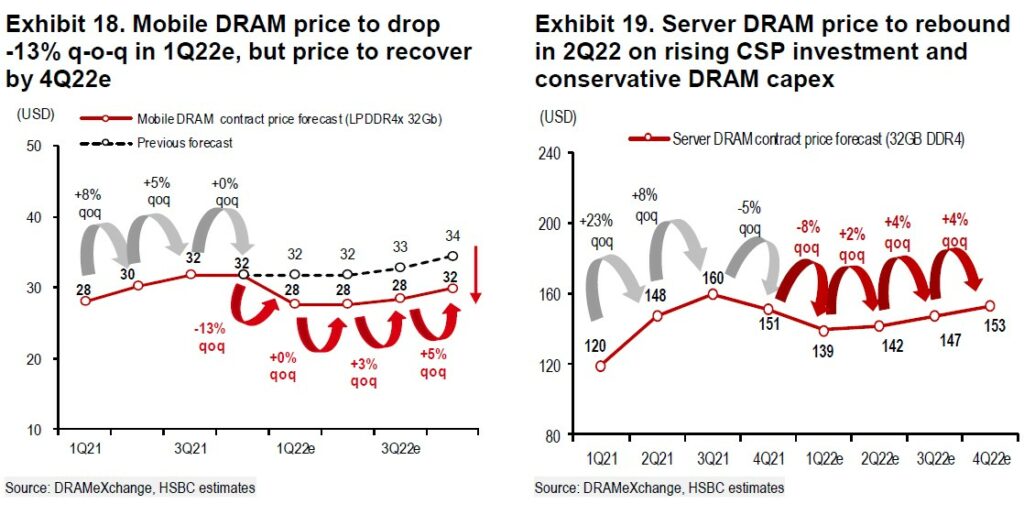
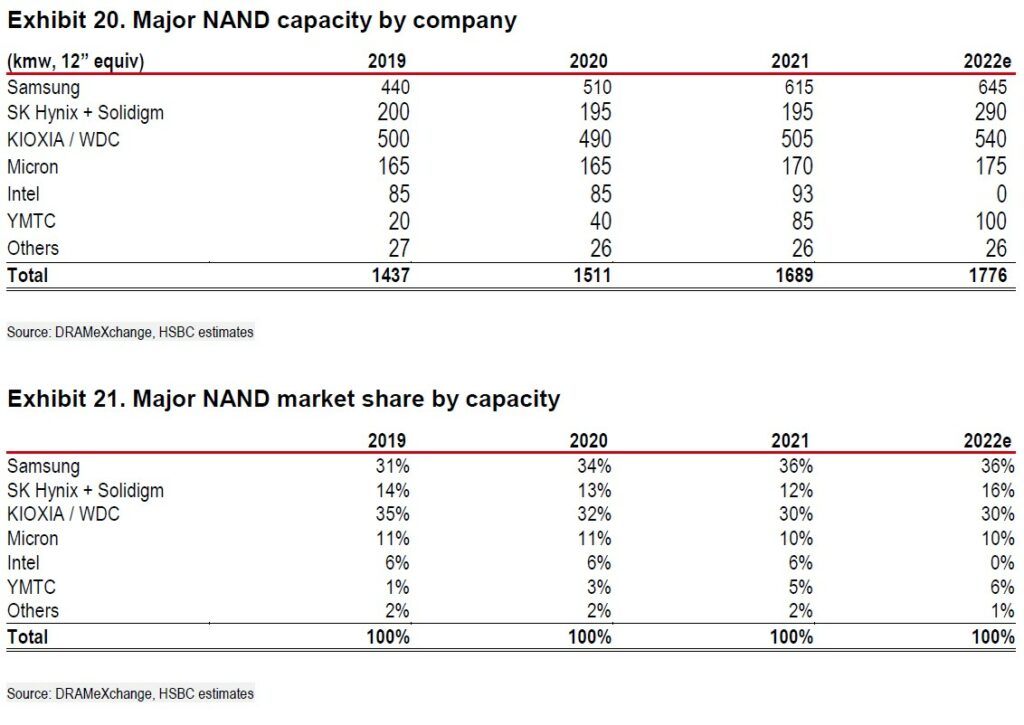

Apple has reportedly made an estimated GBP5B by no longer providing chargers and earphones with its new iPhones. Apple has said the move, announced two years ago, was intended to cut waste and drew praise from environmentalists when it claimed it would reduce annual carbon emissions by 2M tons, the equivalent of taking 500,000 cars off the road. Since announcing the move, Apple is thought to have sold 190M iPhones worldwide. Total gains from removing chargers and earphones, plus reduced shipping costs, could be as high as GBP5B (USD6.5B), with an additional estimated GBP225M from the sale of accessories. (Gizmo China, Daily Mail)
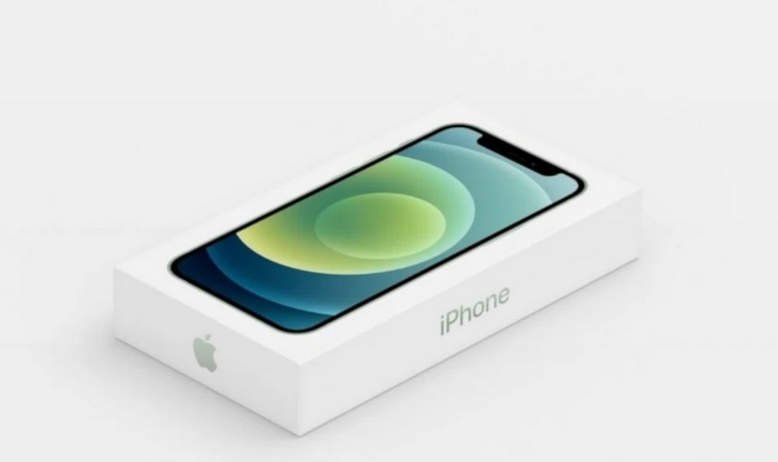

Foxconn has been forced to suspend production after China partially locked down the cities of Shenzhen and Shanghai to combat a jump in COVID-19 cases starting early Mar 2022. Shenzhen is Foxconn’s second-largest manufacturing hub in China. The city of Zhengzhou 840 miles to the north the company’s primary iPhone production site. Regarding the impact of the suspension of production, Foxconn has indicated that the company has made necessary production deployments due to other backup factories to reduce the impact on the company’s operations.(Digital Trends, Bloomberg, Asia Nikkei, The Verge, My Drivers, Axios, Yahoo)
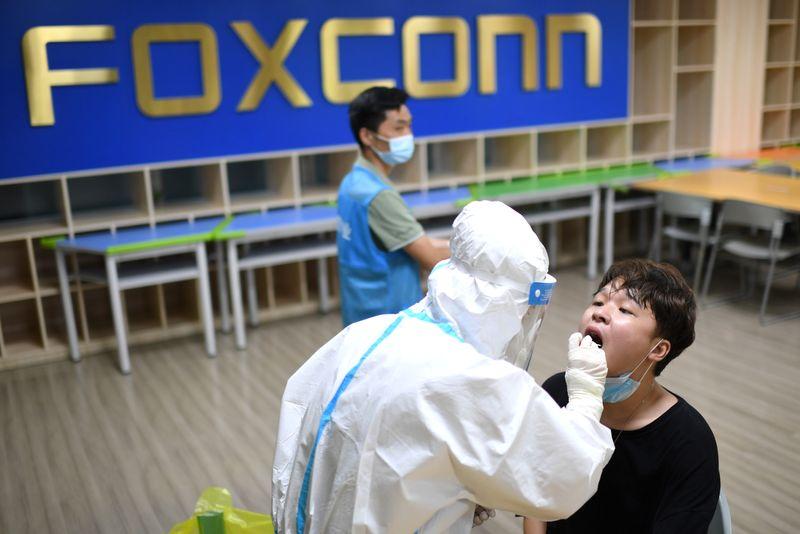

Apart from minting an non-fungible token (NFT) directly on a blockchain or purchasing an NFT in an auction, NFTs can also be bought and sold on market place such as OpenSeas, SuperRare, Nifty Gateway, MakersPlace and Async Art. These marketplaces take commission for the sale of NFTs similar to traditional auction houses and a number of these generated significant revenue in Aug and Sept 2021. These platforms are seen as the start of bringing wider adoption of NFTs to larger communities as well as different industries. (PWC report)
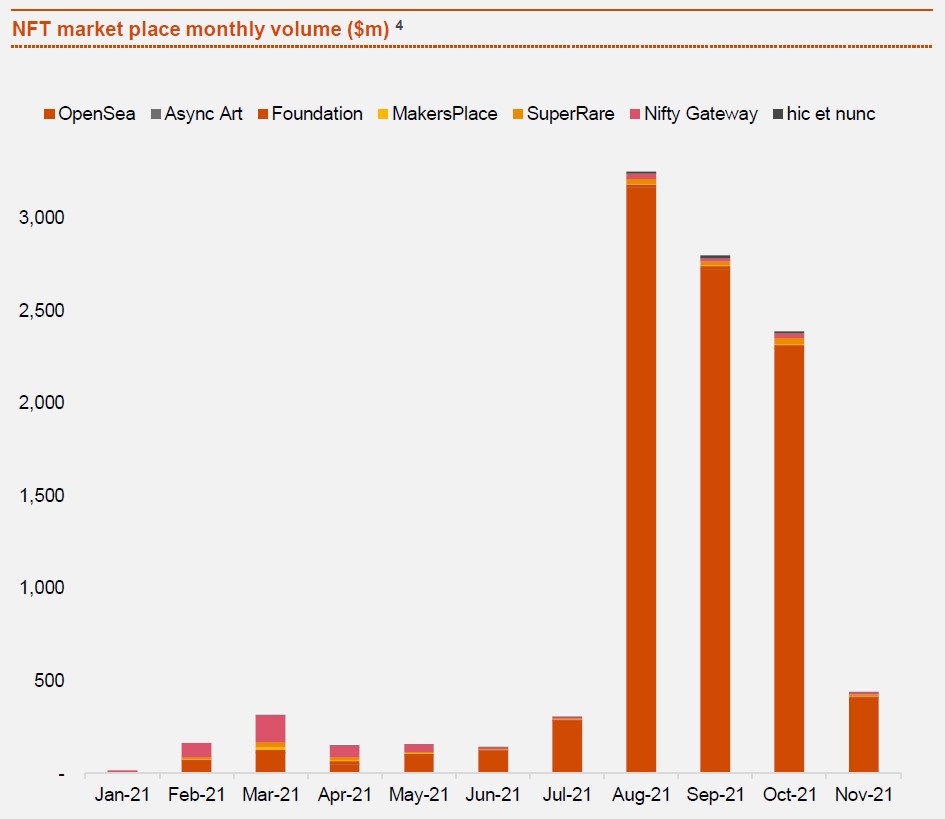
Credit Suisse forecast a 48% / 36% 2020-2025 shipment / revenue CAGR to 42M / USD12.6B 2025 AR/VR devices. The semiconductor sector should further its content gains into user hardware, connectivity, storage and cloud compute. Apparel companies and ad agencies have been early movers in the transition of commerce from internet to metaverse platforms. They believe that three factors can drive additional growth in the next few years: (1) a disruptive AR / VR headset maker emerges amid more applications for enterprises and consumers; (2) a better integrated hardware-software platform emerges to drive penetration; and (3) technological improvements such as micro-LED and fast LCD enable a better price-performance product. (Credit Suisse report)
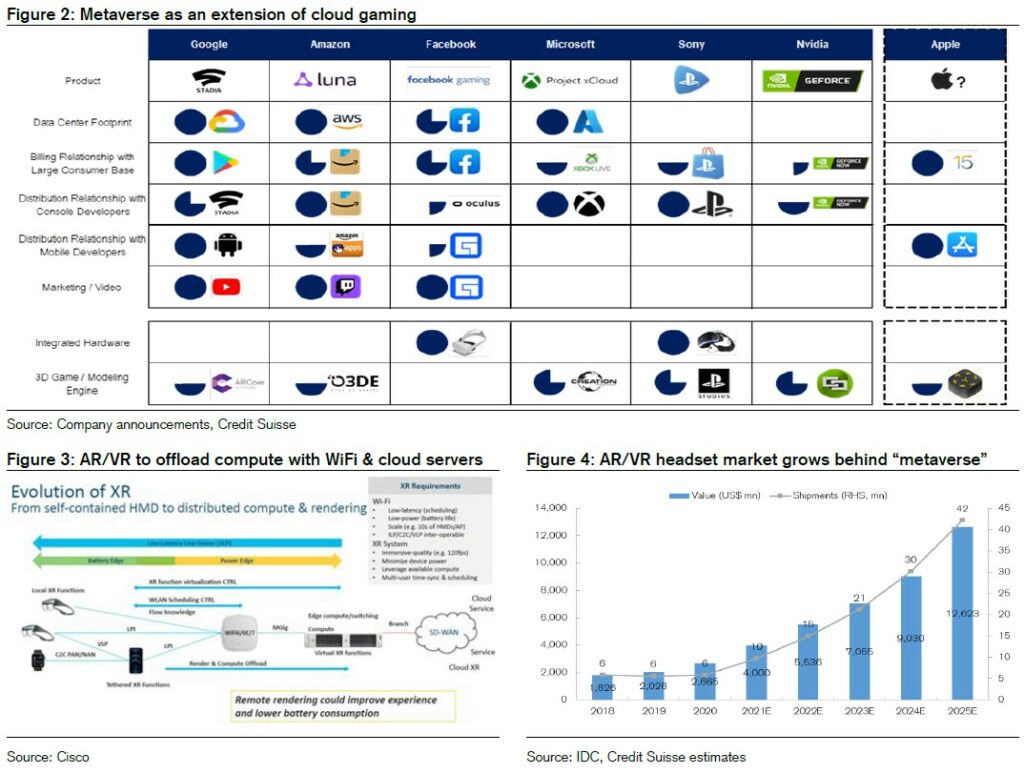
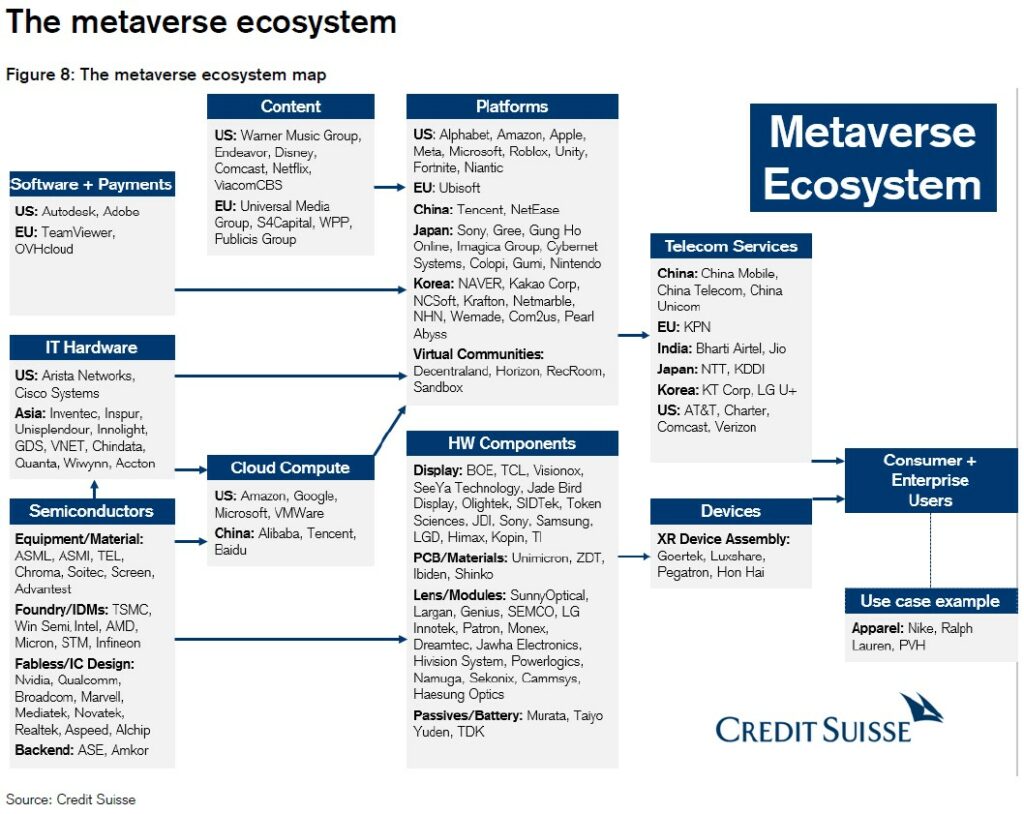
According to Credit Suisse, Oculus remains the major driver of units in the industry since its launch of Oculus Quest 2 in 4Q20. It will see its shipment rise from 7.3M in 2021 to 20.6M by 2025. Sony PSVR 2 and Apple MR (to be released in 2H22 or 1H23), will further facilitate the growth of the AR/VR market. Credit Sussie expects global AR / VR headsets to deliver 42M units (Oculus 20.6M, Apple 7.5M, Sony 3.1M, Pico 3.3M) and the revenue to reach USD12.6B in 2025, representing 48% shipment CAGR and 36% revenue CAGR over 2020-2025. (Credit Suisse report)
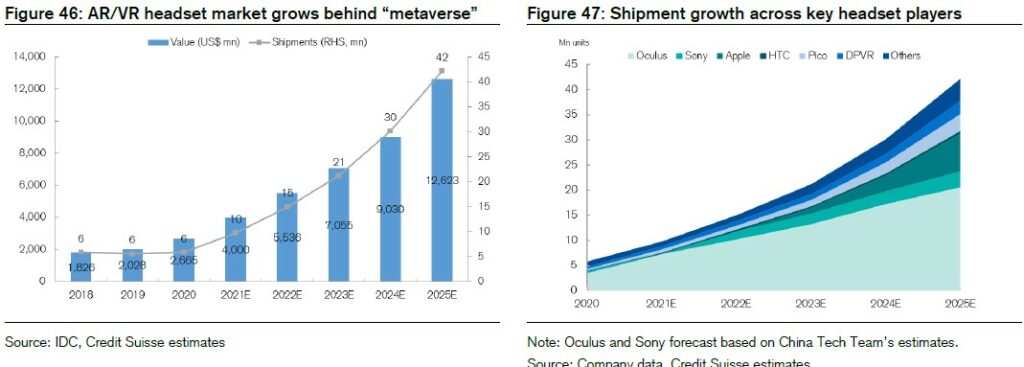

Based on Clarus Commerce’s study on 2,500 consumers, product quality, the passionate community of consumers surrounding the product and the price of the brand’s products are the biggest factors that keep consumers loyal to their favorite brands. They are all things a brand can control and improve. The top three answers here can also depend on one another. A high-quality product is a cornerstone to building community around a brand and rallying a community of loyal supporters can lead to growth, and eventually, a lower price point on products for those in a loyalty program. (Clarus Commerce report)
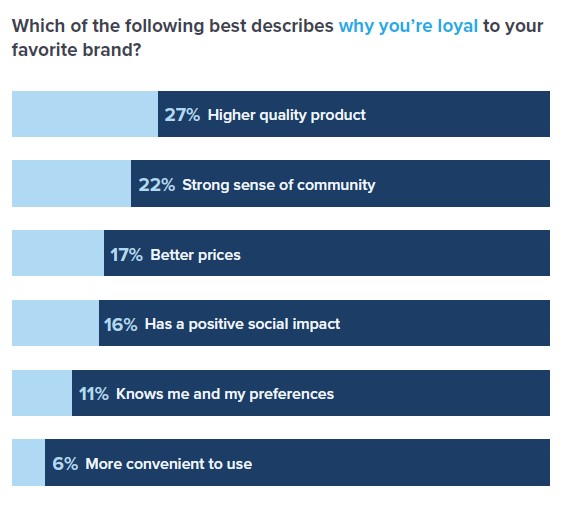
Increases in price and decreases in quality are the leading reasons consumers said they would lose loyalty to their favorite brand and choose another. Additionally, a third of respondents (33%) have said a brand taking a contrary social or political stance to their own could cause them to lose loyalty with their favorite brand. This stat is revealing — but may not hold much weight. (Clarus Commerce report)
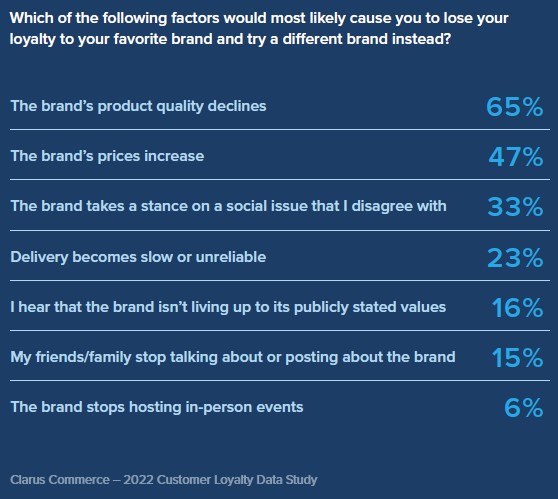
By and large, the factors that influence a customer’s loyalty hit close to home. Opinions of friends and family top the list, with personal politics and the media also playing a large role. Influencers, whether they are paid or unpaid. Unpaid influencers only sway 46% of consumers’ opinions, and even fewer (44%) said paid endorsements influence their opinion. The data here begins to show a pattern — that outside factors have less influence on brand loyalty than we might think. (Clarus Commerce report)
